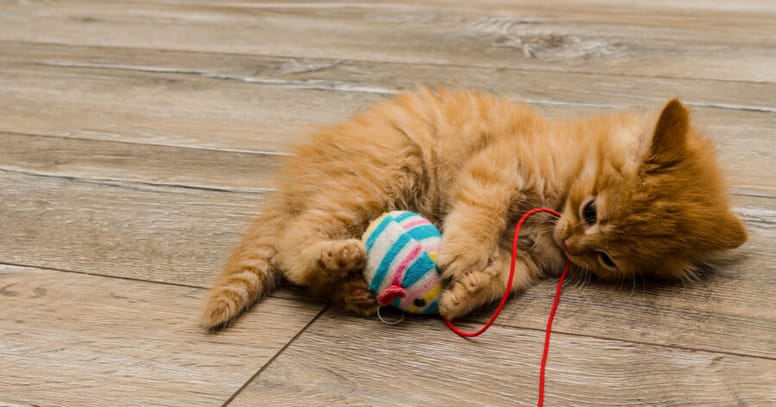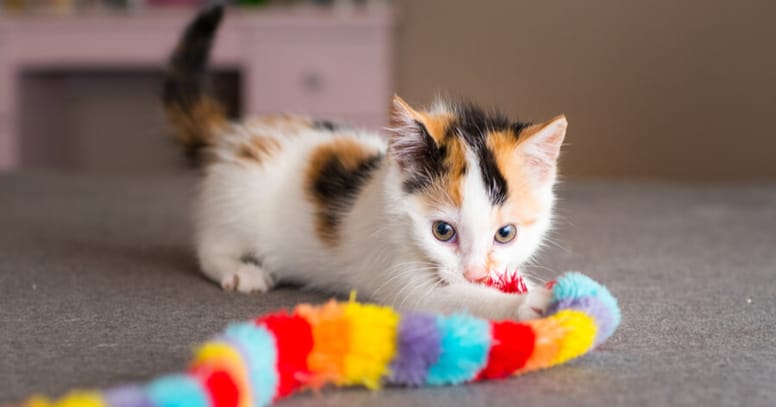In the great scheme of things it costs relatively little to keep your cat or kitten entertained, although some pet toys can be pricey due to their appearance or what they are made from. We take a look at what is arguably more important than appearance and material: the fun factor! Cats love to play; kittens love to play more. And play is a vital part of feline life. Choosing the right toy and the right activity goes a long way to rearing a kitten with an excellent temperament and just the right amount of zing.
Why is play so important for kittens?
For the first two or three months of their life, a kitten’s playtime is centred on mum and the siblings. Throughout this period a kitten learns about its place in the world (at least around other cats), and learns feline boundaries. It is also at its most fearless: its fear reaction only sets in at around the seven week mark.

Kittens grow fast; their bodies are growing all the time and they tire easily. A litter will in the early days sleep or suckle on mum for most of the time. But playtime is never too far away. As the days and weeks pass each kitten learns to understand the meaning of playtime, and learns from their play with the other cats what is and is not acceptable behaviour.
Kitten play: 10 to 12 weeks of age
By the time a kitten reaches its third month it will show an interest in objects further afield, and will exhibit predatory behaviour. It will stalk and pounce on anything it sees in order to hone its hunting skills. Each kitten in a litter learns from the other, who in turn learns from its mum.
A kitten’s locomotive skills are the first to come to the fore. Kittens are incredibly agile creatures, and toys for a kitten this age should include things that encourage it to run, climb and jump. It may look as though a kitten is having fun, and she is, but at the same time her experiences are adding to her adult knowledge and skills.
Kitten play: Onwards from 12 weeks of age
The kitten will soon have all of the skills needed of adulthood. If you are lucky enough to look after a kitten so young you will notice its play fighting, either with you or one of its siblings. It will also be adept at pouncing, jumping and darting around the room.
Kitten play: Interactions with humans
Playing with a kitten at this age is extremely useful. You will be responsible for building the kitten’s confidence around people, its behaviour and its wily nature. You will also be helping her to stay healthy physically and mentally, because she will feel stimulated and rewarded when you play with her.
Your cat’s ancestors - the wild cats - are often seen play fighting and chasing smaller creatures. In much the same way that cats in the wild need to learn vital hunting and social skills your cat is doing the same. Domestic cats and wild cats are still close enough in an evolutionary sense to share the same behaviours.
Which toys are best for kittens?
There are many toys on the market for kittens and cats. But remember: a kitten will be as stimulated by positive interaction with you as it will be with a climbing tree or laser pen! There is no need to spend lots of hard-earned money on toys. Things such as a paper bag (not plastic), or a cardboard box are just as entertaining to a kitten.

We look here at which toys are best specifically for kittens that are active, inquisitive and sociable.
Best toys for the energetic kitten
Some breeds of cat are more active than others; the same is said of the kittens of certain breeds. Breeds with a reputation for being highly active and in need of constant attention include the Siamese, Abyssinian and Oriental. Breeds with less of an energetic streak include the Persian, Himalayan and British Shorthair.
For energetic cats and kittens, opt for a toy that encourages movement. A cat climbing tree offers the ideal challenge to a cat full of beans, so too a cat tunnel or toy full of catnip that it can chase around the floor.
Alternatively invest in a laser pointer: shining it on objects, you can tempt your cat to dart around the room in an attempt to ‘catch’ the light.
Feline obesity
Such exercise-inducing toys are not only a useful means to tire your cat. So too do they ward off obesity. Cats that do not exercise enough will quickly gain weight; a fat adult cat may develop diabetes or a painful condition such as osteoarthritis; for a young cat to become obese will not do.
Best toys for the hunting kitten
A kitten is forever honing its hunting skills. We may think we have domesticated cats as we have dogs – and to an extent we have – but they still believe they are wild animals in search of their next meal! Try toys that move of their own accord for a cat that enjoys the thrill of the chase.
Fabric hats, feather toys, fake fish and small animals powered by a zany motor will keep your kitten on its toes for hours. Fishing-rod toys are an excellent way to combine the chase with some positive human interaction.

Best toys for the brainy kitten
Most kitten toys on the market provide a variety of challenges, and almost all of them provide mental stimulation. Giving your kitten a toy that mentally challenges her will go some way to prevent feline boredom. Research tells us that a kitten that grows up indoors thrives on mental enrichment. Conversely, one that grows up without may exhibit problematic behaviour.
A 2010 study of the environmental enrichment of indoor cats found that “cats maintain their natural behaviours, such as scratching, chewing, and elimination, while living indoors, and they may develop health and behaviour problems when deprived of appropriate environmental outlets for these behaviours.”
Just 20 minutes a day of play with toys such as a Peek-a-Boo battery-operated toy, self-rotating ball or rotating teaser toy provides a sufficient ‘outlet’ for a kitten, and will ensure that her development is not marred by boredom and frustration. A cat scratching post is also a useful addition to your household.
What are some of the best kitten toys?
The answer is determined by the type of kitten you own. If you own a cat that is constantly on the move, invest in a toy that will wear it out. If you think your cat is easily bored try a toy that will stimulate its interest and even provoke a degree of problem solving. Perhaps more importantly, in addition to providing it with a toy you should make the effort to interact with your cat. Play together and run together. If you do, you may find that your own mental and physical health improves as a result. If nothing else, the bond between you and your cat will grow.

